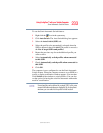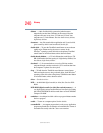
240
Glossary
5.375 x 8.375 ver 2.3
diskette — A thin, flexible disk in a protective jacket that stores
magnetically encoded data. Diskettes can be removed from the
computer and come in two sizes: 5.25-inch and 3.5-inch. Your
computer uses 3.5-inch diskettes. See also double-density diskette,
high-density diskette.
document — Any file created with an application and, if saved to disk,
given a name by which it can be retrieved. See also file.
double-click — To press the TouchPad control button or mouse button
rapidly twice without moving the cursor or mouse. In the
Windows
®
operating system, this refers to the primary TouchPad
control button or left mouse button, unless otherwise stated.
double-density diskette — A 3.5-inch diskette that can hold up to 720
KB of information (half the capacity of a high-density diskette). See
also diskette, high-density diskette.
download — (1) In communications, to receive a file from another
computer through a modem or network. (2) To send font data from
the computer to a printer. See also upload.
drag — To hold down the TouchPad control button or mouse button
while moving the cursor to drag a selected object. In the Windows
®
operating system, this refers to the primary TouchPad control button
or left mouse button, unless otherwise stated.
driver — See device driver.
DVD — An individual digital versatile (or video) disc. See also DVD-
ROM.
DVD-ROM (digital versatile [or video] disc read-only memory) — A
very high-capacity storage medium that uses laser optics for reading
data. Each DVD-ROM can hold as much data as several CD-ROMs.
Compare CD-ROM.
E
emulation — A technique in which a device or program imitates another
device or program.
enable — To turn on a computer option. See also disable.
executable file — A computer program that is ready to run. Application
programs and batch files are examples of executable files. Names of
executable files usually end with a .bat or .exe extension.


















